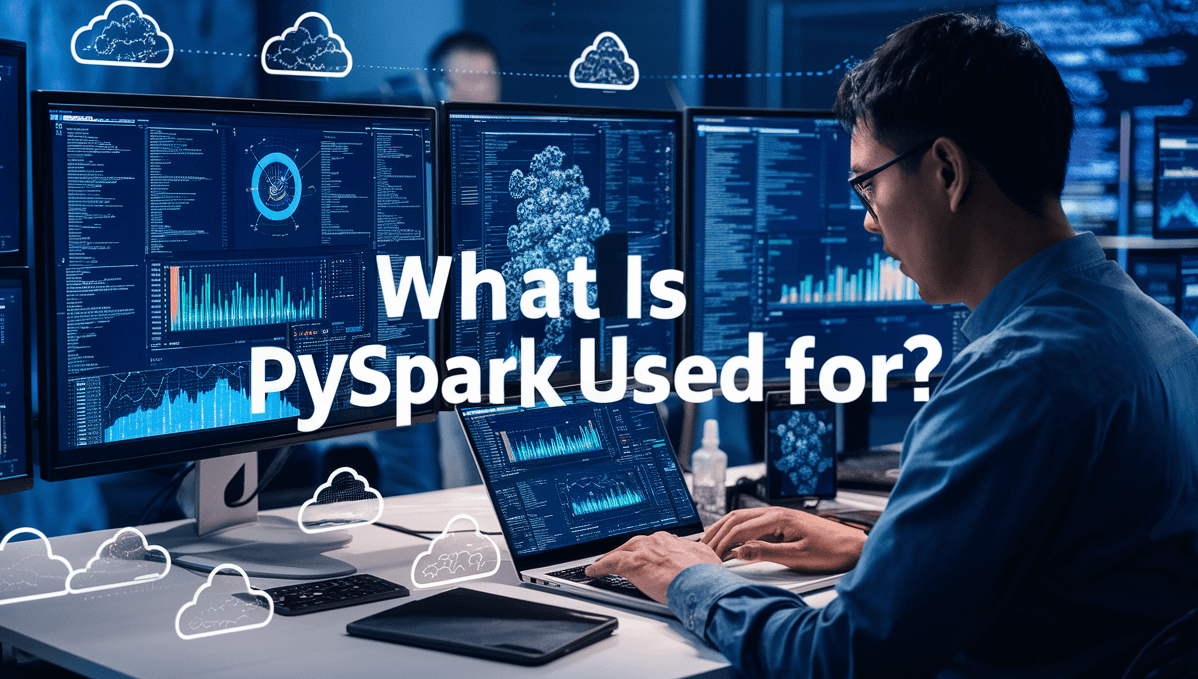In the present business world driven by technology, organizations produce and act on information at an incredibly fast pace. Whether from the likes of social media, e-commerce, or things connected and financial business, data is the heartbeat of modern-day business. However, the sheer volume of data being generated presents a unique challenge. But the question is how do you process and analyze this data in a time-effective and efficient manner? That is precisely where PySpark comes into the picture – as one of the reliable tools for large-scale data analysis.

Jump ahead to
What is PySpark?
PySpark is a Python frontend to Spark, a distributed computing system for big data processing that is open source. While Apache Spark is written in Scala, PySpark handling embraces the opportunity to work in Python – one of most straightforward and widely used languages within community of developers.
Apache Spark is an extendable programming model for Explicitly Parallel Computing that spans across many computers. There are APIs for various languages such as Java, Scala and R but PySpark brings ‘Pythonic’ way of working to sparkle which is more easily approachable by data scientists and engineers who are well versed with python’s data processing libraries for data science.
What is PySpark Used For?
As we know what PySpark is now, let’s look at potential use cases of it. PySpark is an incredibly versatile tool, applicable in various fields. It extends the functionality of Spark to point that all stages of data analysis can be implemented within PySpark. This is from preprocessing data to learning through developing models.
Big Data Processing
In its simplest sense, PySpark is a framework that facilitates working with extremely large data sets. Conventional systems may not be capable of maintaining and processing big data efficiently. PySpark, because of its distributed processing framework, can simultaneously solve for structured and unstructured data across clusters of computers.
ETL (Extract, Transform, Load) processing is the most commonly applied job activity utilizing PySpark. It enables organizations to acquire data from several sources, and then clean, transform and load it, for storage in a database data warehouse. Moreover, it is relatively simpler than Spark and allows for manipulation of big complex data in a way that is easily understandable as we have seen above since it follows the DataFrame API similar to how one would use pandas.
Real-Time Stream Processing
Besides the batch processing, PySpark also features in stream processing hence enabling real time data analysis. This is of special help for use cases. It includes fraud detection, analysing data from IoT sensors or real-time recommender systems.
Spark Streaming is another component of Spark which allows us to handle stream data through PySpark. Liveness is critical for applications that require near-instantaneous responses to incoming data, or for data that is generated in real time, like the surveillance of live network traffic for the indication of fraudulent financial transactions.
Data Analysis and Artificial Intelligence
PySpark MLlib is a distributed library for large-scale machine learning in Apache Spark. It makes users able to do classification, regression, clustering, and collaborative filtering with ease. This makes it a very useful tool for data scientists, as well as machine learning engineers when handling big data.
While with machine learning models training data can be a big issue because often large volumes of data are needed. PySpark makes doing this easy and faster since it divides data into a cluster and carrys out computations simultaneously in the construction and deployment of machine learning models.
Data Wrangling and Cleaning
Usually, data cleaning or “wrangling” takes more time than any other activity related to data analysis projects. Luckily, PySpark has many features that help approach these tasks and prepare the data for analysis. One can deal with the missing data, delete redundant columns or rows, hide unnecessary records and make aggregations or transformations with vast tables within minutes.
API is DataFrames, it provides users with an interventional way to work with structured data. Since it is designed for users to get familiar with SQL or python’s data frame from pandas. This aspect of it is one of the main reasons why PySpark is favored over other available frameworks such as Hadoop MapReduce for big data preprocessing.
Graph Processing
Another incredible use of PySpark is in graph processing due to GraphX. Relationships in data are often depicted using graphs and that is why graphs are used in social networks, recommendation engines and networks.
What one can do with PySpark is, represent a structure of the data as a graph, nodes, edges, perform mathematical functions, Page Rank, connected components, etc,. This causes very large graphs to be processed efficiently because of the distributed nature of PySpark.
Data Pipeline Management
Due to its compatibility with even other aspects of big data processing like Hadoop, HDFS and Apache Kafka, PySpark is perfect for creating robust and complex, big data systems. Kafka can be used to ingest data and PySpark to process the data Great details stored in HDFS or cloud-based data storage such AWS S3.
When dealing with complex data pipelines, it simplifies the execution of all the processes involved in data acquisition, analysis, and visualization.
Conclusion
PySpark is a highly flexible and very potent tool that can be used to satisfy almost any data processing requirement. From dealing with big data and streaming data to supporting machine learning and graph processing, PySpark Training provides the ability to solve some of the toughest problems that businesses and data scientists face today. Python API it has for big data processing makes it easy to be used by both senior engineers as well as those data scientists who are just getting into the realm of big data.
In the world where data becomes a currency, understanding PySpark can be a complete turnaround for anyone. It gives one the power to process, analyze, and develop insights from data in a very short time. Whether they are a business leveraging data for decision-making or a data scientist to advance their skills, with PySpark the speed, flexibility, and scalability required to succeed in the current data economy are provided.
FAQs
What is PySpark, and why is it used for big data processing?
PySpark is a Python API for Apache Spark, a distributed computing system designed to process large-scale datasets efficiently. It combines the power of Spark with the ease of use of Python, making it a popular choice for big data tasks.
How does PySpark handle large datasets?
It leverages Spark’s distributed architecture to process data across multiple machines in parallel. It significantly improves performance and scalability for handling massive datasets.
How does PySpark compare to other big data tools like Hadoop?
It offers several advantages over Hadoop, including faster processing speeds, in-memory caching, and a more flexible programming model.
Can PySpark be used for real-time data processing?
Yes, PySpark’s Spark Streaming component enables real-time data processing. This makes it suitable for applications like fraud detection and IoT data analysis.
What are some common challenges faced when working with PySpark?
Common challenges include understanding Spark’s distributed architecture, optimizing performance for large datasets, and effectively managing complex data pipelines.
Is PySpark suitable for machine learning tasks?
Absolutely! PySpark’s MLlib library provides a comprehensive set of machine learning algorithms for tasks like classification, regression, clustering, and collaborative filtering.
What are the benefits of using PySpark for data analysis?
It offers several benefits, including improved performance, scalability, flexibility, and integration with other big data tools.
How does PySpark compare to other Python-based data analysis libraries like Pandas?
While Pandas is excellent for smaller datasets, PySpark’s distributed capabilities make it more suitable for handling large-scale data processing tasks.



